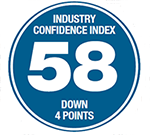 The construction market has been growing steadily for the past few years. Many industry executives are predicting a slowdown in this growth, however. Some execs see this potential slowdown as a natural part of the construction cycle. But for many, there is a wait-and-see attitude pending the results of November’s presidential election.
The construction market has been growing steadily for the past few years. Many industry executives are predicting a slowdown in this growth, however. Some execs see this potential slowdown as a natural part of the construction cycle. But for many, there is a wait-and-see attitude pending the results of November’s presidential election.
The ENR Construction Industry Confidence Index for the third quarter shows that, of the 245 executives of large construction and design firms responding to the survey, most believe market growth will begin to level off in 2017. The CICI index was 58 on a scale of 100, down four points from the second quarter.
The CICI measures executive sentiment about the current market and reflects the respondents’ views on where it will be in the next three to six months and over a 12- to 18-month period. The index is based on responses to surveys sent out to more than 6,000 U.S. firms on ENR’s lists of leading general contractors, subcontractors and design firms. The latest survey was conducted from Aug. 30 through Sept. 28.
|
Click to View the Third-Quarter Cost Report |
As with last quarter, the buildings sector showed a sagging level of confidence among construction executives. The CICI ratings fell in five of the nine buildings sectors in this quarter, after the ratings in six of the nine sectors sagged in the previous quarter. The executives polled in this quarter now see the markets in the commercial buildings, retail, and entertainment and cultural sectors as effectively flat over the next 18 months.
On the infrastructure side, some of the euphoria has worn off over the passage of the federal Fixing America’s Surface Transportation (FAST) Act, and execs are getting impatient for the outcome of the pending vote on the federal Water Resources Development Act. As a result, confidence in the growth of the transportation and water-and-waste markets have moderated.
The soon-to-be-released results of the latest Confindex survey from the Construction Financial Management Association, Princeton, N.J., demonstrates that executives are more worried about the current market than what is coming in 2017. CFMA polls 200 CFOs each quarter from general and civil contractors and subcontractors.
CFMA: Wait Till Next Year
While a Confindex rating of 100 indicates a stable market, higher ratings show growth is expected. “Our Confindex rose one point, from 121, in the second quarter to 122 [on a scale of 200] in this quarter,” says Stuart Binstock, CEO of CFMA.
The individual categories that make up the Confindex rating show reasons for contractors to be optimistic about 2017, says Binstock. The survey’s “current business conditions” component fell three points, to 126, but the “year ahead” rating rose six points, to 117.
Binstock attributes the sag in current business conditions to the uncertainty surrounding the presidential election. He says many projects have been put on hold until owners know who will be president and get a sense of the policies of the new administration. “This uncertainty will be over by the start of 2017,” Binstock says.
For the industry, it doesn’t matter so much who gets elected. A bigger problem is that projects are being put on hold due to the uncertainty during the run-up to the presidential election, says Anirban Basu, CEO of economic consultant Sage Policy Group Inc., Baltimore, and CFMA economic adviser.
“We are beginning to see some pent-up demand as owners defer building decisions until after the election. Irrespective of who is elected, we will know what the regulatory environment will look like after the election,” Basu says.
Basu says firms in the infrastructure sector should be happy, regardless of who is elected. “Secretary Clinton has proposed a five-year, $250-billion infrastructure spending plan—plus an infrastructure bank, to encourage added spending, and Donald Trump has proposed to double this amount for infrastructure improvements,” Basu notes.
The buildings market, which has been booming over the past few years, is beginning to see some bumps in the road. Some sectors, such as multi-unit residential and commercial buildings, may be getting overbuilt in some cities. Multi-unit residential, long one of the highest-rated sectors in the CICI survey, dropped eight points, to a 55 rating, this quarter.
Uncertainties in Project Financing
Part of the problem may be the availability of project financing. Each quarter, ENR asks survey respondents whether the availability of project financing is easier or tougher now than it was six months ago. For the first time in several years, more people said project financing was tougher to obtain than those who believed it was easier. While 60% of survey participants say project financing has been unchanged over the past six months, 22% now say it has become tougher to obtain financing.
Binstock says this concern is mirrored in CFMA’s Confindex survey. “The percentage of our CFOs that are very concerned about the lack of bank lending for projects jumped to 14% from 7% in this quarter,” he notes.
Basu says bank regulators are becoming increasingly concerned about the percentage of bank portfolios invested in real estate. “Building sectors, particularly in residential and commercial, may be getting overbuilt in some cities, causing lenders to reassess their exposure to the real estate market,” he says.






